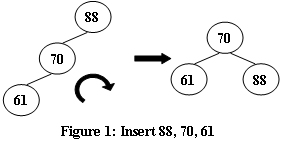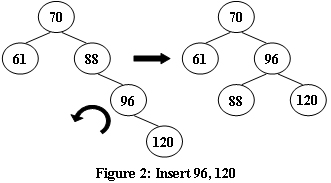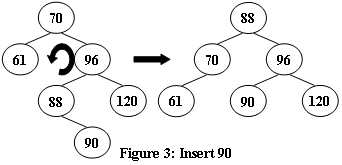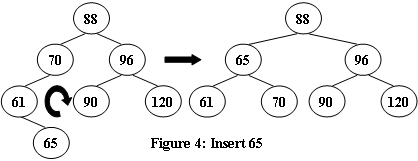04-树5 Root of AVL Tree(25 分)
An AVL tree is a self-balancing binary search tree. In an AVL tree, the heights of the two child subtrees of any node differ by at most one; if at any time they differ by more than one, rebalancing is done to restore this property. Figures 1-4 illustrate the rotation rules.


Input Specification:
Each input file contains one test case. For each case, the first line contains a positive integer N (≤20) which is the total number of keys to be inserted. Then N distinct integer keys are given in the next line. All the numbers in a line are separated by a space.
Output Specification:
For each test case, print the root of the resulting AVL tree in one line.
Sample Input 1:
5
88 70 61 96 120
Sample Output 1:
70
Sample Input 2:
7
88 70 61 96 120 90 65
Sample Output 2:
88
1 #include<iostream> 2 using namespace std; 3 struct treenode{ 4 int data,h; 5 treenode* left=NULL; 6 treenode* right=NULL; 7 }; 8 using tree=treenode*; 9 int height(tree t){ 10 //cout<<"height(tree t)"<<endl; 11 if(!t) return 0; 12 return max(height(t->left),height(t->right))+1; 13 } 14 tree RotateLL(tree t){ 15 //cout<<" RotateLL(tree t)"<<endl; 16 tree a=t->left; 17 t->left=a->right; 18 a->right=t; 19 a->h=max(height(a->left),height(a->right))+1; 20 t->h=max(height(t->left),height(t->right))+1; 21 return a; 22 } 23 tree RotateRR(tree t){ 24 //cout<<"RotateRR(tree t)"<<endl; 25 tree a=t->right; 26 t->right=a->left; 27 a->left=t; 28 a->h=max(height(a->left),height(a->right))+1; 29 t->h=max(height(t->left),height(t->right))+1; 30 return a; 31 } 32 tree RotateLR(tree t){ 33 //cout<<"RotateLR(tree t)"<<endl; 34 t->left=RotateRR(t->left); 35 return RotateLL(t); 36 } 37 tree RotateRL(tree t){ 38 //cout<<"RotateRL(tree t)"<<endl; 39 t->right=RotateLL(t->right); 40 return RotateRR(t); 41 } 42 tree insert(tree t,int v){ 43 //cout<<" insert(tree t,int v)"<<endl; 44 if(t==NULL){ 45 t=new treenode(); 46 t->data=v; t->h=0; 47 return t; 48 }else if(v<t->data){ 49 t->left=insert(t->left,v); 50 if(height(t->left)-height(t->right)==2) 51 if(v<t->left->data) 52 t=RotateLL(t); 53 else t=RotateLR(t); 54 }else{ 55 t->right=insert(t->right,v); 56 if(height(t->left)-height(t->right)==-2) 57 if(v>t->right->data) 58 t=RotateRR(t); 59 else t=RotateRL(t); 60 } 61 t->h=height(t); 62 return t; 63 } 64 int main(){ 65 int n; 66 cin>>n; 67 tree t=NULL; 68 for(int i=0;i<n;i++){ 69 int v; cin>>v; 70 t=insert(t,v); 71 } 72 cout<<t->data<<endl; 73 return 0; 74 }

